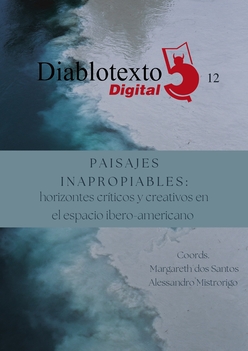“Memory sites” against historical silence. The Second Spanish Republic female teachers’ perspective in the novel La maestra republicana (2013) by Elena Moya
DOI:
https://doi.org/10.7203/diablotexto.12.25242Keywords:
memory sites, woman teachers, 20th century, literatures Abstract
Abstract
The novel La maestra republicana (2013) by Elena Moya portrays an introspective journey of Vallivana Querol, a former Republican teacher, towards the 20th century. This remembrance is led by “memory sites”, described by Pierre Nora as places that carry past memories within them ([1984] 2008). The main objective of my research is to analyse the literary recreation of these spaces from the critical and intimate perspective of the female protagonist. For that purpose, the studies of Astrid Erll in Memoria colectiva y culturas del recuerdo (2012) will provide the theoretical basis for the analysis of the novel as a literary vehicle to reawake the remembrance of past epochs and to review collective memories.
 Downloads
Downloads
 References
References
AGUILERA, Juan (2011). “Las fundadoras del Lyceum Club femenino español”, Brocar, 35, pp. 65-90.
ASSMAN, Jan (1995). “Collective Memory and Cultural Identity”. Traductor John Czaplicka, New German Critique, 65, pp. 125-133.
ASSMANN, Aleida; CONRAD, Sebastian (2010). Memory in a Global Age. Discourses, Practices and Trajectories. Londres: Palgrave Macmillan.
BALLARÍN, Pilar (1999). “Maestras, innovación y cambios”, Instituto de Estudios de la Mujer, vol. 6, n.º 1, pp. 81-110
BURKE, Peter (2005). ¿Qué es la historia cultural? Barcelona: Piados.
CAPEL, Rosa M.ª (2009). “Patrimonio en la escuela. El archivo de la residencia de señoritas”, CEE Participación Educativa, n.º 11, pp. 156-161.
CARTMELL, Deborah et al. (2001). Retrovisions. Reinventing the Past in Film and Fiction. Londres: Pluto Press.
CUBILLOS, Marcela (2007). “Transitando entre historia y literatura. Recuperar la pasión por el pasado y el laberinto de lasoledad”, Logos, 17, pp. 106-115.
DELGADO, Miguel A (2016). “Victoria Kent y Louise Crane, el amor que desafió al Franquismo”, en https://cultura/historia [22 de enero de 2022].
ERLL, Astrid (2012). Memoria colectiva y culturas del recuerdo: estudio introductorio. Bogotá: Universidad de los Andes
FERNÁNDEZ, Donato (2016). “La crisis económica española: una gran operación especulativa con graves consecuencias”, Estudios Internacionales, 138, pp. 119-151.
FLECHA, Consuelo (2005). “Maestras que dejan huella.” Treinta retratos de maestras. Madrid: Cuadernos de Pedagogía.
HIRSH, Marianne (2008). “The Generation of Postmemory”, Poetics Today, 29, 1, pp. 103-128.
LAUGE, Hans (2016). “Modes of Remembering in the Contemporary Spanish Novel”, Orbis Litterarum, 71, 4, pp. 265-288.
MARTÍNEZ, Luz; HERRERO, Carmen (2016). “La educación en la Segunda República”, FETE-UGT. En https://laescueladelarepublica.es/wpcontent/uploads/2016/09/Unidad_didactica_secundaria2.pdf [Fecha de consulta: 22 de enero de 2022]
MENDOZA, Jorge (2011). “Dos materiales a la memoria colectiva: cine y literatura”, El alma pública, pp. 82-93.
MORENO, Francisco (2001). “Huidos, maquis y guerrilla: una década de rebeldía contra la dictadura”, La represión bajo el franquismo, 43, pp. 11-137.
MOYA, Elena (2013). La maestra republicana. Madrid: Novoprint.
NASH, Mary (2012). “Las mujeres en el último siglo”, 100 años en femenino. Una historia de las mujeres en España. Editoras Oliva María Rubio e Isabel Tejeda, Acción Cultural Española, pp. 25-52.
NORA, Pierre (2008). Lieux de mémoire. Traductora Laura Masello. París: Trilce.
RAMOS, Sara (2006). “Control y represión. Estudio comparado de los resultados de la depuración del magisterio primario en España”, Revista Complutense de Educación, vol. 7, n.º 2, pp. 169-182.
RIGNEY, Ann (2004). “Portable Monuments: Literature, Cultural Memory, and the case of Jeanie Deans”, Poetics Today, 25, 2, pp. 361-396.
RIGNEY, Ann (2008). “Fiction as a mediator in National Remembrance”, Narrating the Nation. Editores Stefan Berger, Linas Eriksonas and Andrew Mycock, Berghahn Books, pp. 79-96.
ROIG, Montserrat (2013). “La recuperación de la palabra”, Mujeres Olvidadas. Las grandes silenciadas de la República. Editora Antonina Rodrigo, La esfera de los libros, pp. 13-26.
TODOROV, Tzvetan (2000). Los abusos de la memoria. Traductor Miguel Salazar Barroso. Barcelona: Paidós.
TORRES, María (2012). “Las guerrilleras silenciadas”, Los ojos de Hipatía, (2020) en https://lhistoria/las-guerrilleras-silenciadas/ [4 de marzo de 2022]
YUSTA, Mercedes (2015). “Con armas frente a Franco. Mujeres guerrilleras en la España de posguerra”, Heterodoxas, guerrilleras y ciudadanas, pp. 175-195.
VÁZQUEZ, Raquel (2015). “La Residencia de Señoritas de Madrid durante la II República: entre la alta cultura y el brillo social”, Espacio, tiempo y educación, vol. 11, n.º 1, pp. 323-346
Downloads
Published
How to Cite
-
Abstract332
-
PDF (Español)232
Issue
Section
License
Licencia de reconocimiento de Creative Commons “Reconocimiento - No Comercia l- Sin Obra Derivada
Authors who publish with this journal agree to the following items:
The authors will keep their copyright and guarantee the journal the right of first publication of their work, which will be simultaneously subject to the Creative Commons license that allows third parties to share the work indicating its author and its first publication in the journal. The authors may adopt other non-exclusive license agreements to distribute the version of the published work (e.g., depositing it in an institutional telematic file or publishing it in a monographic volume), with an acknowledgment of its initial publication in this journal. The authors are allowed and encouraged to disseminate their work through the Internet (e.g., in institutional telematic archives or on their website) before and during the submission process, which can produce interesting exchanges and increase citations of the published work. (See Effect of Open Access)




